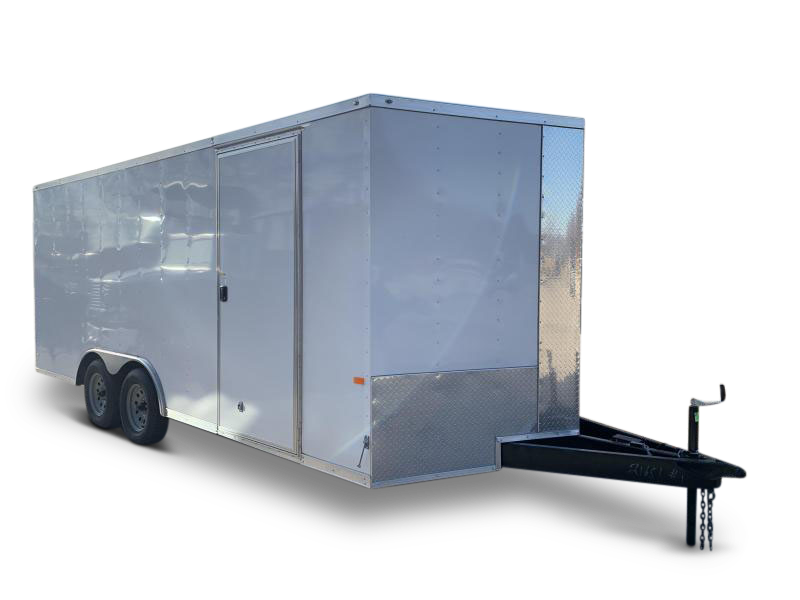
If you’ve been around enclosed cargo trailers enough, you will have experienced or seen that terrible moment when back and forth sway occurs on the roadway. A weight distribution hitch is an incredibly useful tool for trailer owners to employ to help combat the dreaded “trailer sway” that can occur at high speeds.
In this issue of our enclosed trailer guide series, our trailer pros are laying out all the ins and outs of a weight distribution hitch and covering why these safety devices are essential for anyone hauling heavy cargo.
How Does A Weight Distribution Hitch Work?
Anyone hauling enclosed cargo trailers can tell you that proper weight distribution is a must. Especially with heavy cargo, having an unbalanced load can mean less control, more wear and tear on specific components, and can even lead to an accident. Balancing the load around the axle is key.
A weight distribution hitch acts under that same principle as loading up your cargo in an evenly distributed way. When a trailer hitch is connected to the tow vehicle, there’s a lot of weight on the center, at the point of connection. So instead of all this weight hitting dead center on a standard hitch, a weight distribution hitch is going to take the stress and distribute it evenly throughout the plane of connection between the tow vehicle and trailer. This results in less stress at the rear of the vehicle and conversely at the front of the trailer.
A Closer Look at the Mechanics
Also known as a load-equalizing hitch, a weight distribution hitch relies on adjustable spring bars and the physics of tension in order to create a uniformly distributed weight throughout the enclosed trailer up to the tow vehicle’s axles.
You’ll see three main components inside of a weight distribution hitch that provides the inherent benefits of the system. These include the ball mount, the hitch receiver, and the spring bars.
All of these clever design mechanics of a weight distribution hitch simply make it safer and more efficient to haul heavy cargo wherever it needs to go.
Benefits Weight Distribution Hitches Provide Trailer Owners
At their core, weight distribution hitches rely on providing balance between two key trailer measurements every owner should be very familiar with in the gross weight of the trailer combined with that of the cargo, as well as the tongue weight rating. When these two figures are imbalanced in either direction, the trailer hitch can sink, raise, or cause sway.
We already know that an imbalanced trailer can be very dangerous so in walks a weight distribution hitch to make sure the trailer is in zen-like balance with the tow vehicle at all times.
The key benefits to employing a hitch with weight distribution are many, including:
- Evenly distributed weight – okay, so this one is a given but it’s absolutely crucial to the mission of a weight distribution hitch. This dramatically helps reduce motion up and down.
- Drastically reduces swaying tendencies – with a trailer that’s been loaded properly and that has a weight distribution hitch, occurrences of that terrible back and forth sway should be virtually eliminated.
- Can increase the tow capacity of the trailer – without as much of a tongue load to account for, you may be able to get safely closer to the actual payload capacity of the trailer. Helping to haul heavier loads is definitely the hallmark of a weight distribution hitch.
- Easier to maintain control – not having the nerve-rattling sway or up and down that can come with hauling a heavy cargo trailer means smoother sailing for long hauls. When you need to stop and turn, you’ll notice a far better degree of responsiveness than what you may have experienced with a fully loaded trailer that didn’t have a weight distribution hitch installed.
- Increased stability – sway can occur at the most terrible moments, like from a passing semi or a sudden gust of wind, the weight distribution hitch helps to absorb these external forces to give you better stability throughout the trip.
- Decreased wear and tear – both your enclosed trailer and your tow vehicle will thank you a thousand times over for installing a weight distribution hitch. The uneven distribution can really do a number on a variety of components, so they’ll simply wear out faster. Decreased wear and tear means the investment in a weight distribution hitch really pays off over time.
Whenever our customers ask us about options like a weight distribution hitch, we always focus on the value received for the investment made. With a weight distribution hitch, you’re getting a safer ride, a more efficient trailer operation, and less wear and tear.
Two Different Types of Weight Distribution Hitches
In the wide world of weight distribution hitches, there are two distinct kinds of hitches, each with its own advantages. The main difference between the two types lies within the unique spring bar system that comprises each weight distribution hitch.
Trunnion Bars Weight Distribution Hitches
Trunnion bars help to provide a great leveling system for the overall towing operation you have running. Most trunnion bars handle capacities running from 5,000 to 15,000 lbs. The trunnion bar weight distribution hitch has a pre-torqued trailer ball, as well as sway control. Trunnion bars are best used when you have heavier cargo that needs to be transported.
Round Bar Weight Distribution Hitches
Round bars have spring bars that attach to the bottom portion of a ball mount. These systems are great for a nice, smooth and stable towing experience. Round bars have slightly less weight capacity with ranges hitting typically from 5,000 to 14,000 lbs, depending on the manufacturer.
How Do You Know If You Need a Weight Distribution Hitch?
While it can sometimes just be a personal preference for a smoother ride and easier control, there are some telltale signs that you can be cognizant of that can mean it’s time to look at weight distribution hitches. If you experience things like a gross trailer weight rating that’s greater than 50 percent of the overall gross vehicle weight rating.
The gross vehicle rating is the total combined weight of the fully-loaded trailer and tow vehicle and is something that’s specified by your vehicle’s manufacturer. As a good rule of trailer-hauling, you should always know exactly what your GVWR is and never push the limits of what your vehicle can safely handle. Additionally, feeling any kind of loss of control or swaying in the course of your normal activities hauling an enclosed trailer are pretty good indicators that a weight distribution system should be on your radar.
Lastly, once you load up your trailer and have everything hooked up to your vehicle, take a step back and physically look at the setup. Do you notice your trailer dipping down at the tongue and the rear of the tow vehicle sagging or the front of your vehicle pointing up? If so, you most likely need a weight distribution system.
Best Situations to Use a Weight Distribution Hitch
Weight distribution hitches to be used with enclosed trailers are usually employed when heavy cargo needs to go longer distances but they can be just as useful in everyday situations.
A few of the situations where it can be especially beneficial to employ a weight distribution hitch can include:
Of course, anyone looking for a safer and easier ride may find it really beneficial to go ahead and install a weight distribution hitch. If you’ve ever seen or experienced trailer swaying, this alone can be enough to convince you how much it’s worth to have this system in place before your next towing adventure.
Weight Distribution Hitches and Towing Capacity
When you have a weight distribution hitch, you will in some cases increase the amount you can tow. That’s because the weight distribution hitch lets you tow to the actual capacity of the hitch. This isn’t so much increasing the overall towing capacity as simply letting you take advantage of the limits already there.
Always, always check your vehicle’s hitch rating to know what the towing capacity is. Most will list two limits – one with a weight distribution system and one with a standard ball mount. Class III, IV, and V hitches are designed to work with weight distribution to create a safe tow operation. It’s important to know all of your vehicle’s ratings as no matter what, the lowest-rated component will be the safe limit.
Talk Weight Distribution Hitches With a Renown Trailer Guru
For hauling those heavy-duty loads, a weight distribution hitch can be a real lifesaver. Interested in learning more about how a weight distribution hitch system can make your life as a trailer owner easier? Call, click or come on in to our trailer dealership in beautiful Douglas, GA. Our seasoned trailer professionals can answer all of your questions and review your options for having this vital safety and performance system installed on your enclosed trailer.
